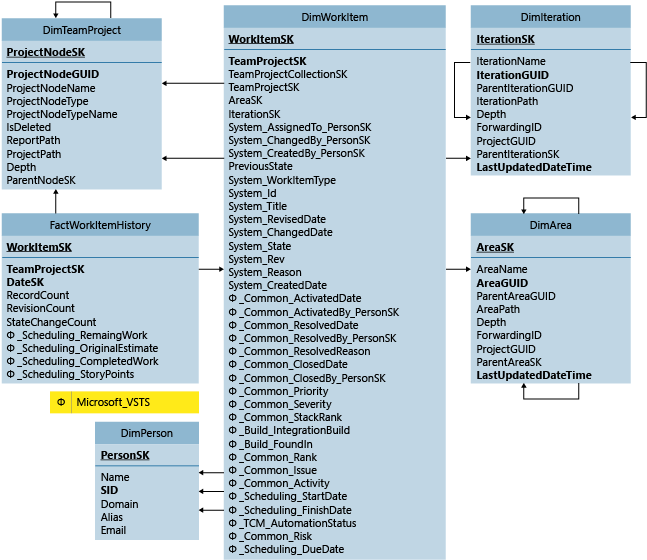You can query for historical data about bugs, tasks, and other types of work items by using FactWorkItemHistory and the associated dimension tables as the following illustration shows. Historical data provides information about the status of a work item or a value of a field for a work item as it changed over time. Progress and burndown charts are examples of reports that are built from work item history tables. The data is stored by using compensating records.
For information about the measures and dimensions that are associated with these tables in the SQL Server Analysis Services cube, see Analyze and report on work items and test case data using the Work Item perspective.

FactWorkItemHistory is associated with the following dimension tables:
DimArea
DimIteration
DimPerson
DimTeamProject
DimWorkItem
You can use the following sample query to find the historical workload trend for the period between 2009-09-21 and 2009-09-30 for certain user stories. For each user story in the team project, this query returns information about the total completed work, the original estimated work, the remaining work, and the total story points for every day during that period.
 Note Note |
|---|
This query assumes that a user story is linked to other work items through child links. |
 Copy Code Copy Code | |
|---|---|
declare @TeamProjectNodeSK int select @TeamProjectNodeSK = ProjectNodeSK from GetProjectNodeInfoFromReportFolder(N'/TfsReports/VSTSDF/ProcessDev10') -- This table value function returns the ProjectNodeSK: the Surrogate Key of a team project under a certain area path. declare @TeamProjectCollectionGuid nvarchar(36) select @TeamProjectCollectionGuid = pc.ProjectNodeGUID from DimTeamProject p inner join DimTeamProject pc on p.ParentNodeSK = pc.ProjectNodeSK where p.ProjectNodeSK = @TeamProjectNodeSK -- This query finds the team project collection GUID by joining TeamProject.ParentNodeSK to TeamProject.ProjectNodeSK | |
 Copy Code Copy Code | |
|---|---|
select
d.DateSK
,wi.System_Title
,wi.System_Id
,coalesce(sum(wih_child.Microsoft_VSTS_Scheduling_CompletedWork), 0) as Total_CompletedWork, -- Finds the total number of hours of completed work.
coalesce(sum(wih_child.Microsoft_VSTS_Scheduling_OriginalEstimate), 0) as Total_OriginalEstimate --Finds the total number of hours of original estimate.
,coalesce(sum(wih_child.Microsoft_VSTS_Scheduling_RemainingWork), 0) as Total_RemainingWork--Finds the total number of hours of remaining work.
,coalesce(sum(wih_child.Microsoft_VSTS_Scheduling_StoryPoints), 0) as Total_StoryPoints --Finds the total story points.
from
DimDate d
cross apply
DimWorkItem wi
cross apply
GetWorkItemsTree(@TeamProjectCollectionGuid, wi.System_Id,
N'Child', d.DateSK) wit
left join
FactWorkItemHistory wih_child
on wih_child.WorkItemSK = wit.ChildWorkItemSK
where
d.DateSK >= N'2009-09-21 00:00:00.000'
and d.DateSK <= N'2009-9-30 00:00:00.000'
and wi.TeamProjectSK = @TeamProjectNodeSK
and wi.System_WorkItemType = N'User Story'
and wi.System_ChangedDate <= d.DateSK
and wi.System_RevisedDate > d.DateSK
and wi.System_State = N'Active'
and (wih_child.RecordCount != -1 or wih_child.RecordCount is null)
group by d.DateSK, wi.System_Id, wi.System_Title | |
 Additional resources
Additional resources
For more information, see the following page on the Microsoft Web site: COALESCE (Transact-SQL)
For more information about compensating records, see the following page on the Microsoft Web site: NEricson's Weblog.
